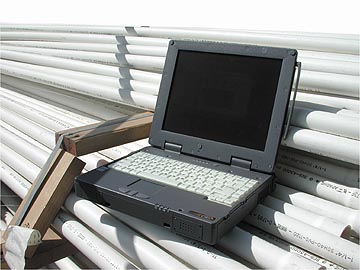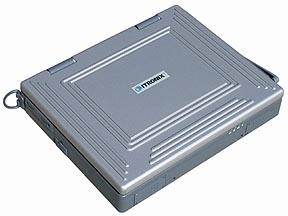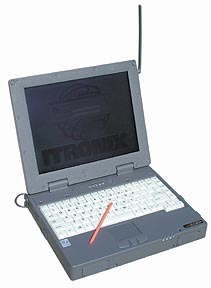|
|
|||||||||||||||||||||||||
Itronix GoBookFor when the going gets really tough (July 2001 issue) Time,
however, does not stand still. Technology and marketing conditions change more
quickly than ever. New generations of relatively inexpensive handheld devices are
gradually replacing Windows 9x-based notebooks and tablets. Itronix is well
prepared in that arena with two Windows CE devices--the T5200 mini notebook and
the FEX21 that came with the acquisition of Husky--and a trio of flashlight-style
handhelds that also originated at Husky. The venerable X-C 6250 soldiers on as
the 6250 Pro, now powered by a 300MHz GXm processor. That choice of processor,
plus the switch to a more powerful 4,500Ahr battery indicates that the 6250 Pro
has been optimized for the longest possible battery life at acceptable speed.
That's because its role within Itronix' lineup has changed since the introduction
of the GoBook.
Likely conceived as an answer to Panasonic's line of rugged, yet
stylish Toughbooks, the GoBook is larger and sleeker than the utilitarian
Cross Country clamshells. It has the roughly 12 x 10-inch footprint of a standard
notebook and the kind of large, bright color screen that seemingly no one wants
to do without these days. Don't let the more civilian looks fool you, though: the
GoBook is one tough, mean magnesium machine with nary a piece of plastic in
sight. All structural components are die-cast magnesium and the entire device is
built to withstand water, shock, drops, and temperature extremes that would kill
most standard notebooks in an instant. To meet one of the dreaded MIL-SPEC tests,
the GoBook had to survive 26 3-foot drops--almost unimaginable for an almost seven
pound notebook with a 12.1-inch TFT screen. Yet, somehow the GoBook did manage to
survive. As mentioned above, it is also billed to pass a number of other MIL-SPEC
810E tests for water resistance, dust and vibration. Add to that a temperature
operating range from minus 10 degrees Fahrenheit all the way to 140 degree
Fahrenheit and you have a piece of equipment that can likely take more abuse than
its human operator.
As you look at the GoBook from all sides, you will see that all ports
are completely sealed via very sturdy plastic doors with foam rubber moldings.
The hinges of these doors are made of metal and unlikely to break (and actually
rated for 30,000+ openings and closings). Finally, there is no way that any of
those doors will inadvertently pop open. Each is securely held in place with not
one but two spring-loaded locks that need to be pulled in opposite direction in
order to pry open the door. All individual connectors are sealed with rubber
plugs attached to the unit so that they won't get lost.
While many rugged computers maintain a respectful distance to the
state-of-the-art, Itronix made liberal use of leading edge technology while
maintaining a sensible balance between features, performance, usability and
reliability. The GoBook uses a 600MHz Intel Celeron processor that provides
spritely performance. Itronix documentation also indicates the availability of a
700MHz Mobile Pentium III CPU. Both processors are low voltage designs that use
0.18 micro process technology and a 100MHz bus. The Pentium III is more powerful
thanks to a newer architecture (the Celeron uses the Pentium II core) and 256k
versus 128k onboard L2 cache. In real life, a clean, streamlined system software
setup is far more important than such minute processor differences. Itronix
claims that additional processor upgrades will become available. The standard
64MB of RAM can be upgraded to 256MB. RAM upgrade slots are below a cover on the
bottom of the GoBook. The same expansion bay also contains a modem/Ethernet slot
that in our test unit was occupied by an ActionTec MP100IM modem/LAN combo card.
Disk storage comes in the form of shock-mounted 2.5-inch drives, mounted in a
separate suspension cradle under the keyboard, with capacities of 6 (standard),
10, or 20GB. The battery is a "smart"5400mAh Lithium-Ion pack. The optional
secondary Li-Ion battery that fits into the expansion bay has a capacity of
3000mAh. The main battery can be replaced in suspend mode without rebooting.
Itronix has years of experience in providing wireless communication in
rugged devices. That experience shows in the seamless, interference-shielded
integration of a variety of radio options into the GoBook. Wireless modules
supporting CDPD, Motient,, Cingular, GSM or wireless LANs are housed in a special
wireless bay accessible through the bottom of the GoBook. The flexible 6-inch
rubber antenna is permanently mounted at the right top of the LCD cover.
The GoBook's 12.1-inch color SVGA LCD seems almost small in this day
and age of 14.1-inch and 15-inch notebook screens. How spoiled we've become. Just
a few years ago, the kind of ultra-bright, crisp 12.1-inch screen would have
seemed a miracle of technology. Even today, it's definitely large enough (Apple's
celebrated new iBook has a 12 inch screen) and the good part of the 800 x 600
resolution is that everything is large enough to easily read even under less than
ideal conditions. Antiglare coating provides a degree of outdoor readability.
While the big LCD likely remains one of the more vulnerable parts of the GoBook,
its magnesium back and dual shock absorption layers provide decent protection.
All GoBooks come standard with both a passive touchscreen and a touchpad with
three-button control.
As I am looking at the Itronix GoBook I cannot help but marvel at how
far we've come in rugged computing. This Itronix machine provides all the desktop
computing power I need, yet it's also tough enough to serve as a high tech
computing and decision support tool in the harshest environments. And once the
work is done, you can even pop in a DVD and watch a movie. Amazing. -
-
|
|||||||||||||||||||||||||
|
[Homepage] All contents ©1995-2001 Pen Computing Magazine, Inc. All rights reserved. |
 We reviewed Itronix' line of "Cross Country" computers in our August 1996 and
April 1999 issues. Both times the compact, sturdily built notebooks impressed
with their combination of performance and bulldog-like ruggedness. The 1996 and
the 1999 versions actually looked pretty much the same--no need to mess with a
successful platform that was right from the start. What did change was the
underlying technology. The 96' X-C 6000 had a 50MHz 486 processor, a 260MB PC
Card hard drive, and an 8.2-inch reflective monochrome screen. The 99' model was
much more advanced, sporting a 200MHz Pentium MMX processor, an internal 3.2GB
2.5-inch hard disk, and a 10.4-inch SVGA TFT color screen. We congratulated
Itronix for keeping its rugged notebooks technologically updated.
We reviewed Itronix' line of "Cross Country" computers in our August 1996 and
April 1999 issues. Both times the compact, sturdily built notebooks impressed
with their combination of performance and bulldog-like ruggedness. The 1996 and
the 1999 versions actually looked pretty much the same--no need to mess with a
successful platform that was right from the start. What did change was the
underlying technology. The 96' X-C 6000 had a 50MHz 486 processor, a 260MB PC
Card hard drive, and an 8.2-inch reflective monochrome screen. The 99' model was
much more advanced, sporting a 200MHz Pentium MMX processor, an internal 3.2GB
2.5-inch hard disk, and a 10.4-inch SVGA TFT color screen. We congratulated
Itronix for keeping its rugged notebooks technologically updated.  Though at first site the GoBook looks pretty much like an ordinary
notebook, closer examination quickly reveals how Itronix' flagship managed to
pass all those tests. The "NiteVue"keyboard, for example, is a fully waterproof
affair made from ivory-colored phosphorescent plastic. Even in complete darkness,
the black letters on the white keys are completely visible and the keyboard is
neither too bright nor too dark. Top-of-the-line IBM ThinkPads now sport a little
spotlight that illuminates the keyboard. A clever idea, but it doesn't come close
to Itronix' solution.
Though at first site the GoBook looks pretty much like an ordinary
notebook, closer examination quickly reveals how Itronix' flagship managed to
pass all those tests. The "NiteVue"keyboard, for example, is a fully waterproof
affair made from ivory-colored phosphorescent plastic. Even in complete darkness,
the black letters on the white keys are completely visible and the keyboard is
neither too bright nor too dark. Top-of-the-line IBM ThinkPads now sport a little
spotlight that illuminates the keyboard. A clever idea, but it doesn't come close
to Itronix' solution.
 Speaking of ports and connectors, while some manufacturers of very
rugged computers seek to minimize the number of ports to cut down on potential
entry points for water and dust, GoBook users will never feel like they had to
accept a compromise. The left side of the GoBook features speaker and microphone
jacks and a Type II or III PC Card slot. In the back you find a RJ-11 modem jack
and a RJ-45 jack for the optional 10/100 Ethernet LAN card. There's a USB port
and a PS/2 port for a mouse, and a bank of full-size parallel, serial, and VGA
ports. On the right side you'll find an expansion bay that can accommodate a
floppy drive, a 24X CD-ROM drive, an 8X DVD-ROM drive or a spare battery. And in
the front are two speakers for that on-the-road stereo sound.
Speaking of ports and connectors, while some manufacturers of very
rugged computers seek to minimize the number of ports to cut down on potential
entry points for water and dust, GoBook users will never feel like they had to
accept a compromise. The left side of the GoBook features speaker and microphone
jacks and a Type II or III PC Card slot. In the back you find a RJ-11 modem jack
and a RJ-45 jack for the optional 10/100 Ethernet LAN card. There's a USB port
and a PS/2 port for a mouse, and a bank of full-size parallel, serial, and VGA
ports. On the right side you'll find an expansion bay that can accommodate a
floppy drive, a 24X CD-ROM drive, an 8X DVD-ROM drive or a spare battery. And in
the front are two speakers for that on-the-road stereo sound.
 The name GoBook suggests dynamic mobility and you can indeed take it
almost anywhere. Though it doesn't come with a handle, there are two heavy duty
metal rings so you can attach a carry handle or shoulder strap. These may be
needed for longer outings because with a footprint of 12 x 9.8 inches, a depth of
2.2 inches, and a weight of 7.5 pounds, the GoBook is a substantial piece of
equipment. For those who need to use their computer in a car or truck, there is
an optional "drop-in"vehicle dock that provides secure mounting, two USB ports,
an external RF antenna, and recharging.
The name GoBook suggests dynamic mobility and you can indeed take it
almost anywhere. Though it doesn't come with a handle, there are two heavy duty
metal rings so you can attach a carry handle or shoulder strap. These may be
needed for longer outings because with a footprint of 12 x 9.8 inches, a depth of
2.2 inches, and a weight of 7.5 pounds, the GoBook is a substantial piece of
equipment. For those who need to use their computer in a car or truck, there is
an optional "drop-in"vehicle dock that provides secure mounting, two USB ports,
an external RF antenna, and recharging.